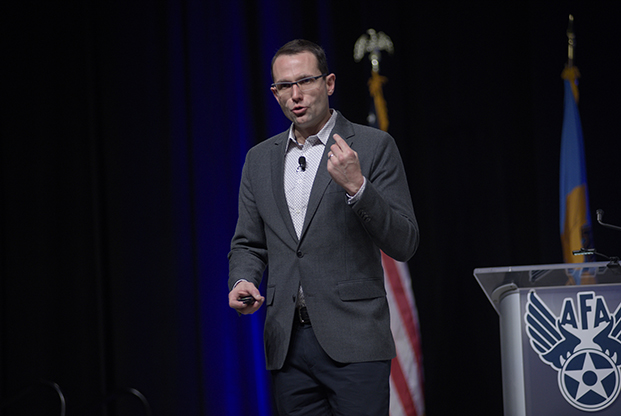
Air Force Acquisition Executive Will Roper speaks about Fielding Tomorrow's Air Force Faster and Smarter at AFA's 2019 Air Warfare Symposium on Feb. 28, 2019, in Orlando, Fla. Staff photo by Mike Tsukamoto.
More software-coding teams are popping up around the Air Force to build on the success of Kessel Run in Boston, the service’s acquisition executive said Friday.
Kobayashi Maru—referring to an impossible training scenario hacked by then-cadet James Kirk in “Star Trek”—is creating code for the Air Force Space and Missile Systems Center, Will Roper said at the Center for Strategic and International Studies.
“We just stood up our second,” he said of Kobayashi Maru. “They have gotten up and are delivering their first code to [Air Force Space Command chief Gen. John Raymond]. Now we’re starting our third.”
That team in Montgomery, Ala., is nicknamed Bespin after a fictional gas planet in the “Star Wars” universe. The Air Force did not immediately provide more information about what the coders are working on.
Roper added that Kessel Run, which started as a military-commercial partnership in August 2017 to fix the failed rollout of Air Operations Center Increment 10.2, is on track to deliver its first cloud-based coding patch for the F-35’s Autonomic Logistics Information System in about a week. That effort is dubbed “Mad Hatter.”
The two new coding groups aren’t the only ones pushing agile development and operations within the Air Force. Last year, the Air Force named Battle Management program executive officer Steve Wert as its digital PEO tasked with spreading Agile DevOps across the service, whether by coding or by new approaches to acquisition.
In one example, a team of intelligence airmen at Offutt AFB, Neb., started “Soaring Buffalo” as their own DevOps lab to address local weapon system improvements.
“One of the many successful projects members of the Soaring Buffalo team has accomplished encompasses creating a dashboard that allows warfighters to make real-time recommendations, designed and coded by airmen with the 595th Strategic Communications Squadron, Air Force Global Strike Command, and targeteers from the 20th [Intelligence Squadron], as well as deployed warfighters from Air Operations Centers,” the service said in a March 12 release.
The Air Force is gradually working Agile DevOps projects like Kessel Run—which don’t fit neatly into the funding buckets for development or procurement—into its regular budgeting process. Roper indicated the service needs to standardize its approach to creating new coding teams as they become a more common part of weapons programs.
“I think one huge litmus test is, are we able, as we stand these up to keep consistency, to have standards so that we can justify the budget to Congress, and eventually go to scale?” he said. “Every program will eventually have to have an agile software pipeline. Software just looks like a service contract. … I don’t know what software development versus sustainment is. It’s just software to me.”
